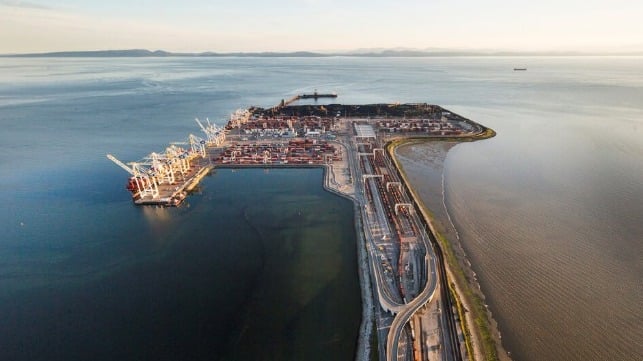Vancouver Pushes Forward with Controversial Roberts Bank Terminal 2 Project

The Vancouver Fraser Port Authority is taking the next key step in its plans to add a major new container terminal to expand Vancouver’s capacity and efficiency. They announced that the search has begun for a contractor for the mega terminal with the goal of selecting a firm with the financial and technical expertise to undertake the massive project by the end of this year.
While the controversial Roberts Bank Terminal 2 (RBT2) project continues to face obstacles, the port authority is pursuing a major step in the implementation of the $3.5 billion project. Implementation of the project has faced unending opposition since its approval by the Canadian government in April 2024.
RBT2 entails the construction of a new man-made island and a three-berth marine container terminal near existing port terminals at Roberts Bank in Delta, B.C. When completed, the terminal is designed to deliver an additional 2.4 million TEU of capacity, ultimately increasing Canada’s west coast container capacity by approximately one-third.
Promoted as a game changer for the port of Vancouver’s long-term growth plans, RBT2 is expected to bolster Canada’s national supply-chain resilience and deliver significant economic benefits. These include more than 18,000 jobs during construction, more than 17,300 ongoing jobs, and support for trade diversification goals by unlocking over $100 billion in new trade capacity and contributing $3 billion in gross domestic product annually.
Since the project was first announced, it has faced opposition from local groups and environmentalists. Last year, several conservationist groups filed a suit opposing its implementation on the basis that it poses adverse risks to endangered species.
Despite the opposition, the port authority is advancing implementation of the massive project that includes the delivery of an approximately 100-hectare marine landmass, a 35-hectare widened causeway, a 1,300-meter wharf structure and berth pocket, and an expanded tug basin. The contract also includes the construction of a marine terminal fish passage to support juvenile salmon migration, and the civil works for onsite habitat enhancement and the South Arm Jetty Tidal Marsh project.
Interested companies have until the end of September to present the bids, with the port authority intending to shortlist three companies before the end of November. They will then be invited to submit a proposal.
“To meet Canada’s needs in today’s quickly evolving trade landscape, we have accelerated our efforts to deliver Roberts Bank Terminal 2, a project that will strengthen Canada’s economic security and deliver trade resilience,” said Victor Pang, Vancouver Fraser Port Authority CFO. “The terminal will be a catalyst for economic transformation nationally, from supporting Prairie grain exports and B.C.’s forestry sector, to communities who depend on reliable and affordable access to essential goods on store shelves.”
Construction of the terminal is planned to begin in 2028 and is expected to be in operation by the mid-2030s. Conceived in 2013, RBT2 has been marketed as a critical infrastructure project addressing challenges as Canadian ports are forecast to hit peak capacity by the early 2030s.
The Port of Vancouver remains Canada's gateway to diverse markets, enabling trade of approximately $300 billion with up to 170 countries annually. This makes the Pacific Gateway the country’s most important trade corridor. Last year, a record 158 million metric tonnes (MMT) of cargo moved through the port, a five percent increase from 150 MMT recorded in 2023.
The West Coast is projected to play an increasing role in Canada’s future trade as it looks to build ties to Asia. Canada looks to build new international opportunities, which kicked off this month with the opening of its first LNG export terminal north of Vancouver and which will be used to supply Asian customers.
